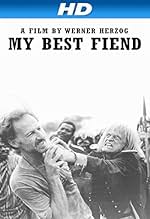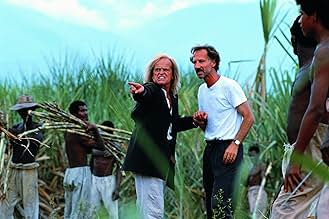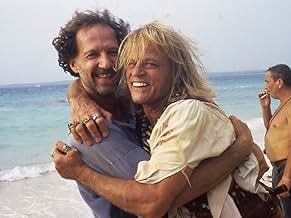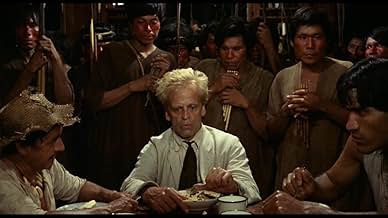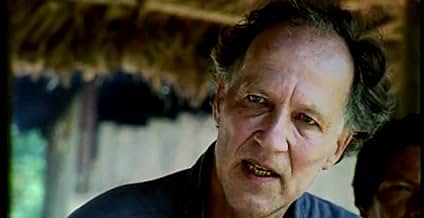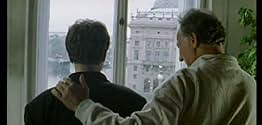Kinski, il mio nemico più caro
Titolo originale: Mein liebster Feind - Klaus Kinski
VALUTAZIONE IMDb
7,8/10
12.739
LA TUA VALUTAZIONE
Anni dopo, avrebbero condiviso un appartamento dove, in un impeto di rabbia di quarantotto ore, lui distrusse completamente il bagno. Da questo caos è nata una partnership violenta, amore-od... Leggi tuttoAnni dopo, avrebbero condiviso un appartamento dove, in un impeto di rabbia di quarantotto ore, lui distrusse completamente il bagno. Da questo caos è nata una partnership violenta, amore-odio, profondamente creativa.Anni dopo, avrebbero condiviso un appartamento dove, in un impeto di rabbia di quarantotto ore, lui distrusse completamente il bagno. Da questo caos è nata una partnership violenta, amore-odio, profondamente creativa.
- Regia
- Sceneggiatura
- Star
- Premi
- 1 vittoria e 2 candidature totali
Klaus Kinski
- Self
- (filmato d'archivio)
Guillermo Ríos
- Self
- (filmato d'archivio)
Andrés Vicente
- Self
- (filmato d'archivio)
Paul Hittscher
- Self
- (filmato d'archivio)
Mick Jagger
- Self - Wilbur
- (filmato d'archivio)
Thomas Mauch
- Self
- (filmato d'archivio)
Jason Robards
- Fitzcarraldo
- (filmato d'archivio)
Walter Saxer
- Self
- (filmato d'archivio)
Recensioni in evidenza
I can't help but like Klaus Kinski. Sure that's easy for me to say, having only encountered him on film, but despite (or probably because of) the madness, the anger and the raving, there's something magnetic about the man. He's like no other actor out there. No one else was so crazy, so passionate and so captivating. He was certainly one of a kind.
However, despite my regard for him as an actor, I can't say that I envy those who had to work with him. Raving fits, shootings and murder plots aren't par for the course when it comes to the majority of movie shoots. Hell, they're not normal by any standards. But then again, Klaus Kinski and Werner Herzog are far from ordinary people. Both had their madness one explicit and one masked and both went to extraordinary lengths to get what they wanted.
I think the piece in the film that best illustrated their shared madness was the story behind Kinski's 'autobiography'. Now to have biography that is largely fictional is nothing new, as people always rewrite their lives, but to have the person that you're insulting have you help insult them is rather extraordinary. It suggests a sadomasochism and a perversity in their relationship. But it also suggests a twisted affection. They hated each other and yet loved each other. No matter how hard they tried they couldn't stop gravitating towards one another.
And it seems that this strange attraction was there from the beginning. After the amazing 'Jesus' footage, the film opens with Herzog reliving his early childhood experiences with Kinski. Just listening to the stuff is amazing. Apparently, before he moved into the halfway house that Herzog used to live in, Kinski used to live naked in an apartment that was filled with leaves. But then once he did move, he proceeded to ruin bathrooms, knock doors down, assault theatre critics ("I was not excellent! I was not extraordinary! I was monumental! I was epochal!"), and my favourite thing of all, rave at the woman who gave him free board, free food, and who did his laundry, for not ironing his shirts neatly enough. The man was a maniac. Yet I can imagine the young Herzog watching these displays in awe. If only someone could harness this energy.
Well, as Herzog's films prove, he certainly harnessed it. But as you'd expect, it was never smooth sailing. Kinski continually caused havoc on set and the bizarre incidents piled up higher and higher. But although listening to Herzog recount these incidents is fascinating enough, the footage itself is amazing. We only get to see snippets of the 'Fitzcarraldo' documentary, but the 'mild' raving fit that is shown illustrates what Herzog was dealing with every day. Sheer madness! In the footage that is shown it's an argument over food, but it really could be anything. Indeed, Herzog often says that Kinski would erupt for the smallest of reasons. But to see Kinski in action is amazing. He's like an animal.
Yet despite the madness, the film also manages to convey Kinski's warmth. There's some wonderful footage at a film festival in America where Herzog and Kinski embrace and joke with one another. In light of what comes before it's really surprising, as it seems impossible to imagine such moments between the two. But when you see it you can't help but come to the conclusion that the two men really did have a deep affection for one another. As well as the hate, there was a lot of love between the two. I also loved the Pongo footage from the 'Fitzcarraldo' documentary. Again you get to see the kindness that Kinski possessed, as he bandages the camerman's hand.
But although the film reveals a lot about Kinski, Herzog still remains something of an enigma. It's clear that he loved and hated Kinski there's one scene where Herzog is talking to a photographer and he suddenly looks overwhelmingly sad, almost like a widower but we're never really allowed to get into his head. In fact, there's one bit where he says that Kinski thought that he was mad but he assures us that he's 'clinically sane'. But as he stands there, holding onto a tree, he does look quite mad. And for all we know he may well be, or may well have had his madness, as what sane person could tolerate Kinski's pestilence?
But mad or not, it doesn't matter. The films that Herzog and Kinski made together are amongst the best in the world, and Herzog's documentary is a captivating, amusing, disturbing, and ultimately, moving tribute to his colleague and friend. The final minutes, in particular, I loved.
However, despite my regard for him as an actor, I can't say that I envy those who had to work with him. Raving fits, shootings and murder plots aren't par for the course when it comes to the majority of movie shoots. Hell, they're not normal by any standards. But then again, Klaus Kinski and Werner Herzog are far from ordinary people. Both had their madness one explicit and one masked and both went to extraordinary lengths to get what they wanted.
I think the piece in the film that best illustrated their shared madness was the story behind Kinski's 'autobiography'. Now to have biography that is largely fictional is nothing new, as people always rewrite their lives, but to have the person that you're insulting have you help insult them is rather extraordinary. It suggests a sadomasochism and a perversity in their relationship. But it also suggests a twisted affection. They hated each other and yet loved each other. No matter how hard they tried they couldn't stop gravitating towards one another.
And it seems that this strange attraction was there from the beginning. After the amazing 'Jesus' footage, the film opens with Herzog reliving his early childhood experiences with Kinski. Just listening to the stuff is amazing. Apparently, before he moved into the halfway house that Herzog used to live in, Kinski used to live naked in an apartment that was filled with leaves. But then once he did move, he proceeded to ruin bathrooms, knock doors down, assault theatre critics ("I was not excellent! I was not extraordinary! I was monumental! I was epochal!"), and my favourite thing of all, rave at the woman who gave him free board, free food, and who did his laundry, for not ironing his shirts neatly enough. The man was a maniac. Yet I can imagine the young Herzog watching these displays in awe. If only someone could harness this energy.
Well, as Herzog's films prove, he certainly harnessed it. But as you'd expect, it was never smooth sailing. Kinski continually caused havoc on set and the bizarre incidents piled up higher and higher. But although listening to Herzog recount these incidents is fascinating enough, the footage itself is amazing. We only get to see snippets of the 'Fitzcarraldo' documentary, but the 'mild' raving fit that is shown illustrates what Herzog was dealing with every day. Sheer madness! In the footage that is shown it's an argument over food, but it really could be anything. Indeed, Herzog often says that Kinski would erupt for the smallest of reasons. But to see Kinski in action is amazing. He's like an animal.
Yet despite the madness, the film also manages to convey Kinski's warmth. There's some wonderful footage at a film festival in America where Herzog and Kinski embrace and joke with one another. In light of what comes before it's really surprising, as it seems impossible to imagine such moments between the two. But when you see it you can't help but come to the conclusion that the two men really did have a deep affection for one another. As well as the hate, there was a lot of love between the two. I also loved the Pongo footage from the 'Fitzcarraldo' documentary. Again you get to see the kindness that Kinski possessed, as he bandages the camerman's hand.
But although the film reveals a lot about Kinski, Herzog still remains something of an enigma. It's clear that he loved and hated Kinski there's one scene where Herzog is talking to a photographer and he suddenly looks overwhelmingly sad, almost like a widower but we're never really allowed to get into his head. In fact, there's one bit where he says that Kinski thought that he was mad but he assures us that he's 'clinically sane'. But as he stands there, holding onto a tree, he does look quite mad. And for all we know he may well be, or may well have had his madness, as what sane person could tolerate Kinski's pestilence?
But mad or not, it doesn't matter. The films that Herzog and Kinski made together are amongst the best in the world, and Herzog's documentary is a captivating, amusing, disturbing, and ultimately, moving tribute to his colleague and friend. The final minutes, in particular, I loved.
My best fiend is not a typical documentary maybe because Klaus Kinski was a rare actor,when you read his biography his life was a mess. Klaus maybe was most famous for his reputation than his career but in Werner Herzog films he became a legend,they did five movies some of them very impressive(Aguirre;Nosferatu...)Kinski with his eccentric personality seems to transcend his roles, we all think we know him:"he was a madman";"a genius";"a misanthropic" etc etc...but who really know him? Herzog?,maybe.For me Kinski was an enigma for that reason we are so intriguing and enchanted by him,in Germany he still the most adored actor;in U.S.A they dont know what to think of him but in the mind of cinephiles around the world he still remains as one of the greatest. Klaus Kinski turned down important movie roles,instead he did some bad films why?he just wanted to make all the films they offered him.He was a great villain not only in real life but in his films as "Jack the Ripper";Nosferatu;Aguirre,and he appears in "For a Few dollars more" as Juan "the hunchback" and even in Dr Zivago; Kinski also directed the film Paganini(Klaus thought of himself as the reincarnation of this famous violinist)He was an unique actor more indomitable than Brando and "My Best Fiend"(an amazing ducumentary)is just one piece of the puzzle on this complex artist.
Werner Herzog's brilliant documentary about his friend Klaus Kinski gives us an insight into the troubled life of this great actor who gave his all to whatever films he elected to appear in. Mr. Herzog offers a different account on Mr. Kinski, who could be infuriating in his egomania, which seems to be at the center of the story. However, one only sees glimpses of the man who could be charming and who could be generous to his fellow actors.
Having met Mr. Kinski on two occasions, we only saw a charismatic man in a relaxed atmosphere. It appears the pressures of making a film propelled the actor into a frenzy that comes out clearly in what Mr. Herzog is showing us in the documentary. Mr. Kinski was probably his own worst enemy because his sense of pride in the role he was portraying took the best out of him. Therefore the hysterics and the fights with his director and the crew, notably the aggression on Justo Gonzalez's head, while playing a violent scene that could have killed him.
On the other hand we catch some of the soft side of the actor as we hear a loving account by Eva Mattes, who played with Mr. Kinski in "Woyzek". Also Claudia Cardinale shares some vivid memories with the director as she recounts her experience with Mr. Kinski while filming "Fitzcarraldo".
The film is an important document, as it illustrates the spirit of a man that was unique in his own madness. Mr. Herzog's shows clearly this actor was a man possessed whenever he played a role in front of a camera. Because of the document we feel enlightened somewhat in having known the man that gave movie fans his best and more.
Having met Mr. Kinski on two occasions, we only saw a charismatic man in a relaxed atmosphere. It appears the pressures of making a film propelled the actor into a frenzy that comes out clearly in what Mr. Herzog is showing us in the documentary. Mr. Kinski was probably his own worst enemy because his sense of pride in the role he was portraying took the best out of him. Therefore the hysterics and the fights with his director and the crew, notably the aggression on Justo Gonzalez's head, while playing a violent scene that could have killed him.
On the other hand we catch some of the soft side of the actor as we hear a loving account by Eva Mattes, who played with Mr. Kinski in "Woyzek". Also Claudia Cardinale shares some vivid memories with the director as she recounts her experience with Mr. Kinski while filming "Fitzcarraldo".
The film is an important document, as it illustrates the spirit of a man that was unique in his own madness. Mr. Herzog's shows clearly this actor was a man possessed whenever he played a role in front of a camera. Because of the document we feel enlightened somewhat in having known the man that gave movie fans his best and more.
I like this documentary and recommend owning it. There are so many scenes that one can jump to to find Kinski's leering face and saying something fantastic. I believe that he somehow opened up his third eye and could no longer see most of the world that we live in. ----Or am I being fooled--- either way, Kinski has left his mark or should I say scar across the face of theatre and film. My only wish is that someone somewhere compiles a volume set of his greatest scenes ranging from a star performance in a well considered artful Herzog film to all of his 'B' movie bombs.
I still enjoy hearing Herzog imitating Kinski and saying, "I was Monumental I was Epical!!!!" ---and his description in the beginning of the doc. when he throws a tantrum that lasts for several days, destroying everything in the bathroom to the point where you could pass every bit through a tennis racket.
That is power. Watch it and believe.
I still enjoy hearing Herzog imitating Kinski and saying, "I was Monumental I was Epical!!!!" ---and his description in the beginning of the doc. when he throws a tantrum that lasts for several days, destroying everything in the bathroom to the point where you could pass every bit through a tennis racket.
That is power. Watch it and believe.
As a kid I saw "Aguirre La Colere de Dieu" on TV and was terrified by Kinski. But after all, what counts is only the film, and on movies you never see the director. Now if you watch "Mein liebster Feind - Klaus Kinski" at last you can see the other side - Werner Herzog. Or have glimpse of it.
Because of course, everything is from Herzog's point of view, so in a way this documentary does not differ from the real movies themselves : you see Kinski acting like a madman in front of the camera or not. Shouting at people. One terrifying scene is an excerpt from Fitzcaraldo where Indians seem to complain about the character played by Kinski, while Herzog is commenting that those very Indians had offered to kill the actor...
Then you've got comments by other people, particularily actresses who witness about Kinski's other side, shy, caring. And the final scene with the butterfly - something Kinski the actor could do, but Aguirre could not. It seems as if Herzog, having showed only one side of Kinski all these years, tries to explain it was all for the movies. Even if he still portrays him as a mad genius (and coward at that), his selective memory tries only to remember the good times, a few rare footage of Kinski and himself having a good laugh.
What the documentary also stresses out is that the director and the actor could have been switched during the filming of Fitzcaraldo : Herzog explains how he was alone against everybody, believing the impossible, like the character in the movie. At this point only, Herzog seems to aknowledge the fact that he also was completely mad.
I recommend watching the documentary, and then watching Cobra Verde, Fitzcaraldo and Aguirre again.
Because of course, everything is from Herzog's point of view, so in a way this documentary does not differ from the real movies themselves : you see Kinski acting like a madman in front of the camera or not. Shouting at people. One terrifying scene is an excerpt from Fitzcaraldo where Indians seem to complain about the character played by Kinski, while Herzog is commenting that those very Indians had offered to kill the actor...
Then you've got comments by other people, particularily actresses who witness about Kinski's other side, shy, caring. And the final scene with the butterfly - something Kinski the actor could do, but Aguirre could not. It seems as if Herzog, having showed only one side of Kinski all these years, tries to explain it was all for the movies. Even if he still portrays him as a mad genius (and coward at that), his selective memory tries only to remember the good times, a few rare footage of Kinski and himself having a good laugh.
What the documentary also stresses out is that the director and the actor could have been switched during the filming of Fitzcaraldo : Herzog explains how he was alone against everybody, believing the impossible, like the character in the movie. At this point only, Herzog seems to aknowledge the fact that he also was completely mad.
I recommend watching the documentary, and then watching Cobra Verde, Fitzcaraldo and Aguirre again.
Lo sapevi?
- QuizIn some footage of one of his notorious on-set flare-ups, Klaus Kinski yells at Werner Herzog that he's "a dwarf director!" This apparently random insult is a specific reference to Herzog's movie Anche i nani hanno cominciato da piccoli (1970).
- Citazioni
Werner Herzog: Every grey hair on my head, I call Kinski.
I più visti
Accedi per valutare e creare un elenco di titoli salvati per ottenere consigli personalizzati
- How long is My Best Fiend?Powered by Alexa
Dettagli
Botteghino
- Lordo Stati Uniti e Canada
- 95.612 USD
- Fine settimana di apertura Stati Uniti e Canada
- 7677 USD
- 7 nov 1999
Contribuisci a questa pagina
Suggerisci una modifica o aggiungi i contenuti mancanti

Divario superiore
By what name was Kinski, il mio nemico più caro (1999) officially released in India in English?
Rispondi

